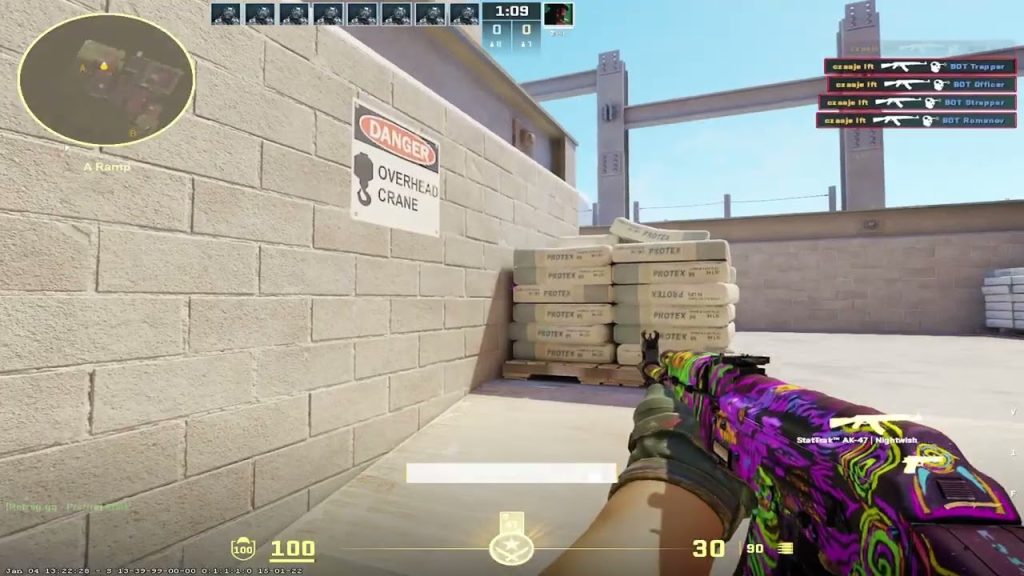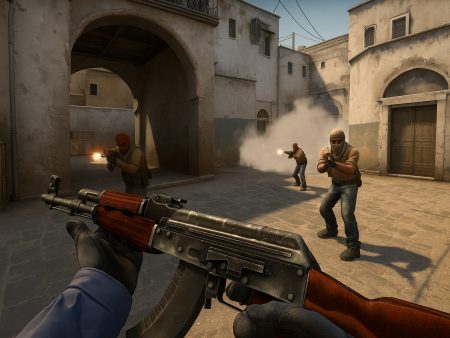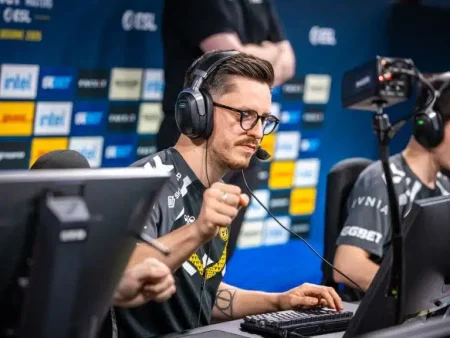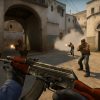Master CS2 with this in-depth guide covering all new mechanics—movement, sub-tick rate, and dynamic utility. Learn how CS2 changes the game and how to adapt like a pro.
When Valve dropped Counter-Strike 2 (CS2), it wasn’t just a facelift. It was a mechanical revolution. Gone are the days of 64-tick frustrations and static smokes. CS2 has redefined how players move, shoot, and strategize, introducing a whole new era of Counter-Strike gameplay. Whether you’re a seasoned CS:GO veteran or a curious newcomer, understanding CS2’s underlying mechanics is the first step to dominating the scoreboard.
This article breaks down CS2’s mechanics into three core areas: movement, tick rate, and utility, giving you a deep but digestible look at how the game now plays. From learning to bunny hop with new fluidity to mastering the impact of sub-tick shooting, we’re diving headfirst into every detail that defines CS2.
So, grab your headset, warm up your aim, and let’s decode what’s really changed in Counter-Strike’s biggest update yet.
Introduction to CS2 Mechanics
What Makes CS2 Different from CS:GO?
At first glance, CS2 may feel like a polished CS:GO, but under the hood, it’s a beast of its own. Valve rebuilt the game using the Source 2 engine, which means virtually every gameplay system got an upgrade—from movement and hit registration to smoke behavior and lighting physics.
Here’s a breakdown of what truly sets CS2 apart:
- Tick Rate Overhaul: No more 64 vs 128 tick debates. Sub-tick updates now dictate player input response.
- Dynamic Smokes: Smokes now interact with the environment, gunfire, and other utilities in real-time.
- Movement Fluidity: Strafing, peeking, and jumping have been refined to feel smoother and more responsive.
- Visual and Audio Revamp: While not strictly “mechanical”, these changes influence how you react in the moment.
While CS:GO was limited by its engine, CS2 opens new doors. And with those doors come new rules you’ll need to master.
Why Understanding Mechanics Is Crucial for Players

Mechanics aren’t just technical fluff—they’re your secret weapon. Players who understand the intricacies of movement and game responsiveness consistently outperform those who don’t. You can have perfect aim, but if your peeking is mistimed or your smoke lands poorly, you’re toast.
Here’s why knowing the mechanics gives you a competitive edge:
- Faster Decision-Making: You’ll know exactly when to stop and shoot or when to strafe out.
- Better Utility Usage: With new physics in play, understanding utility leads to more effective site control or retakes.
- Consistency: Sub-tick mechanics reduce randomness—if you understand them, you’ll shoot with greater reliability.
- Adaptation: With CS2 still fresh, the meta is evolving. Learning the mechanics early positions you ahead of the curve.
Bottom line? If you want to rank up, win clutches, or just not get bodied every round—you need to grasp the engine behind the action.
CS2 Movement Mechanics
Core Movement Systems in CS2
Movement has always been a cornerstone of Counter-Strike. In CS2, Valve has fine-tuned movement to be more responsive, less “clunky,” and more precise. While some mechanics carry over from CS:GO, others feel fundamentally different.
Key movement changes include:
- Smooth Acceleration and Deceleration: Movement transitions feel more natural, making peeks and strafes more controlled.
- Micro-Adjustments Are Easier: With better input handling via the sub-tick system, tiny corrections in crosshair placement or positioning are more effective.
- Animation Syncing: Your character’s animations are now more in sync with what the server registers, reducing the visual desync that often plagued CS:GO.
One of the biggest improvements is how peeking and stopping feels. In CS:GO, players would often “counter-strafe” to stop instantly for accurate shots. While counter-strafing still exists, CS2 smooths out the transition, allowing for more consistent stop-and-shoot mechanics.
Additionally, crouch movement has been tweaked to make sneaky plays more viable without feeling too slow, and surf maps feel closer to Source 1.6 than ever before—a niche bonus for movement lovers.
Strafing, Counter-strafing, and Peeking

Strafing is still the bread and butter of movement, especially in gunfights. In CS2, strafing feels less jarring. This is both a blessing and a curse—it’s easier to pull off clean strafes, but also easier to get punished for predictable movement.
Counter-strafing, the mechanic of tapping the opposite movement key to stop immediately, is more responsive now thanks to sub-tick improvements. You’ll feel this most in dry peeks or jiggle peeks, where pixel-perfect timing matters. Players who mastered counter-strafing in CS:GO will adapt quickly; newer players may find it easier to learn now.
Shoulder peeking has also been enhanced. It’s smoother and more readable—ideal for baiting out AWP shots or clearing angles without over-committing. Movement is now both a psychological and mechanical tool, rewarding players who master its rhythm.
Here are some practical tips:
- Use wide strafes to bait shots.
- Master jiggle peeking with sub-tick responsiveness.
- Learn when to commit vs. disengage based on your movement’s momentum.
Momentum and Speed Adjustments in CS2
Momentum in CS2 has received subtle but impactful adjustments. Your character’s speed builds and decays more naturally, making movement feel more “alive.” This affects everything from jump throws to how fast you can swing an angle.
One noticeable change is how air-strafing behaves. While still present, it’s slightly nerfed, making mid-air corrections harder. Bunny hopping, however, is smoother due to consistent speed retention across hops.
Sprinting doesn’t exist in CS2 (unlike games like Valorant or CoD), but the enhanced movement fluidity makes you feel faster overall. Acceleration curves have also been modified, making pre-aiming while moving feel more precise.
Bunny Hopping: Easier or Harder?
This one’s subjective, but overall—bunny hopping (bhopping) is smoother but less abusable. In CS:GO, skilled players could chain bhops to retain near-max speed. CS2 still allows this but clamps the maximum movement speed more tightly, reducing the exploit potential.
Here’s what’s changed:
- Consistent Air Movement: Sub-tick allows for more reliable air movement inputs.
- Speed Cap Enforcement: You’ll lose speed if you bhop too well—intentional design choice to limit exploits.
- Bhop Scripts Are Harder to Abuse: With improved netcode, the game is better at detecting and punishing external scripts or macros.
If you’re a movement player, you’ll still enjoy bhops, surf maps, and KZ challenges. Just don’t expect to zip around like it’s 1.6 again.
Tick Rate Evolution in CS2
What Is Tick Rate and Why It Matters
Tick rate has been one of the most talked-about—and complained about—topics in Counter-Strike’s history. In simple terms, tick rate is how many times per second the server updates the game state. In CS:GO, the default was 64 ticks, while professional players and community servers preferred 128 ticks for smoother, more responsive gameplay.
Why does this matter?
- Shooting precision: Higher tick rate means your bullets hit exactly when you shoot, not milliseconds later.
- Movement registration: Your jumps, peeks, and strafes sync better with the server.
- Utility accuracy: Smokes, flashes, and grenades land exactly where you intend.
For years, players blamed missed shots or awkward movement on the “low tick rate.” While that wasn’t always the full story, it was a factor. CS2 changes the game with a completely new approach: sub-tick updates.
Sub-Tick System Explained in CS2
Valve introduced sub-tick servers in CS2, rendering the old 64 vs 128 tick debate obsolete. Instead of sending updates every 15.6 milliseconds (as in 64-tick), the server now registers your exact input timing between ticks.
Here’s how it works:
- No More Tick Boundaries: Your input is recorded with ultra-precise timing, so whether you click at 0.001 or 0.015 seconds into a tick, the server knows exactly when.
- More Accurate Hit Registration: Your bullets land based on when you shoot, not when the tick happens.
- Movement Feels Smoother: Especially during fast-paced actions like bunny hops or counter-strafes.
This is a game-changer. It means:
- Players can no longer blame missed shots on tick rate discrepancies.
- Every action you take—peeking, jumping, throwing utility—feels more in sync with what you see on screen.
- The skill ceiling is raised even higher, as micro-reactions are now more reliably tracked.
Impact of Sub-Tick on Shooting and Movement
The most noticeable improvements in CS2 due to sub-tick updates are in gunfights and movement precision. In CS:GO, you’d sometimes feel like you shot first but died anyway. That’s because your input may have landed between ticks, delaying registration. In CS2, that delay is gone.
Effects on gameplay include:
- First Shot Accuracy: Shooting mid-movement or after a quick peek is more likely to hit if timed well.
- Peekers Advantage Adjustment: With sub-tick, the desync between what you see vs. what the enemy sees is reduced, slightly nerfing peekers advantage.
- Utility Consistency: Jump throws, pop flashes, and molotov lineups now land more reliably due to precise movement registration.
Sub-tick responsiveness rewards high-level mechanical skill and timing mastery, giving pros and dedicated players more consistency in how their actions play out.
Comparing Sub-Tick to CS:GO’s 64 and 128 Tick Servers
To truly appreciate the leap, let’s compare sub-tick CS2 with CS:GO’s traditional server setup:
| Feature | CS:GO 64 Tick | CS:GO 128 Tick | CS2 Sub-Tick |
|---|---|---|---|
| Server Updates | Every 15.6ms | Every 7.8ms | Continuous input time recognition |
| Hit Registration | Often delayed | More accurate | Ultra-precise and responsive |
| Movement Sync | Sluggish | Better | Fluid and real-time |
| Utility Timing | Inconsistent | Mostly accurate | Consistently perfect |
| Skill Ceiling | Medium | High | Very high |
Bottom line? Sub-tick isn’t just a new system—it’s a leap forward in competitive FPS technology.
Utility Mechanics in CS2
New Utility Physics and Interactions
One of the most dramatic changes in CS2 is how utility behaves in the game world. Grenades no longer follow simple, physics-lite paths. Instead, they interact with realistic bounce physics, environmental effects, and even other grenades in ways that make every throw more dynamic and tactical.
Here’s what’s different:
- Realistic Bounces: Grenades now bounce more accurately off surfaces based on angle and velocity.
- Collisions with Objects: Utility can interact with map debris, doors, or even active smokes.
- Stacked Interactions: Throwing a flash through a smoke? The effect now changes based on angle and volume density.
These changes mean you’ll need to re-learn your lineup game. Your old Dust II smoke might now bounce differently—or worse, miss entirely. But once mastered, this dynamic system opens up new opportunities for creative plays.
Smokes in CS2: Dynamic Volumetric Smokes
CS2’s most talked-about visual and mechanical update is the volumetric smoke system. Unlike CS:GO, where smokes were static blobs with invisible walls, CS2’s smokes:
- Fill Spaces Naturally: They expand and conform to the map’s geometry.
- React to Environment: Shooting through them temporarily clears the path of visibility.
- Can Be Dispersed: Explosives like HE grenades push the smoke cloud away, opening up angles briefly.
This radically changes how smokes are used both defensively and offensively.
Imagine this:
- You throw a CT smoke to block Banana on Inferno.
- An enemy HE grenade lands just inside the smoke.
- The explosion clears half the smoke momentarily—just enough for the enemy AWP to get a pick.
No more relying on static coverage. Every smoke is now a dynamic battlefield element, creating opportunities for clever plays and counter-plays. It rewards creativity, timing, and fast thinking.
Flashbangs, HE Grenades, and Molotov Changes
Smokes weren’t the only utility to get an overhaul. Flashbangs, grenades, and molotovs have also been tweaked in subtle but meaningful ways.
- Flashbangs: Now cast dynamic light and can behave differently depending on room geometry. A flash thrown in an open area behaves differently than one inside a tight corridor.
- HE Grenades: Besides dispersing smoke, HEs now have slightly adjusted physics for bounce control. They feel heavier—more consistent in landing where you expect.
- Molotovs/Incendiaries: Fire spreads more naturally, adhering to surface geometry and slightly reacting to map features like slopes or edges.
Also, audio cues from utility are more precise, allowing smarter reactions. For instance, you can now better identify where a molotov is burning or if a flash went off behind cover.
How Utility Affects Tactical Play Now
All these utility changes combine to create a fresh tactical meta. Team strategies must evolve to account for:
- Smoke Denial: Don’t rely on one-way smokes—they can be countered with a simple nade.
- Creative Lineups: The dynamic utility system invites experimentation—what works on Inferno may not work the same on Mirage.
- Faster Decisions: Utility windows open and close rapidly now. That split-second smoke gap may be your only chance to push.
Expect pro teams to adapt quickly, and ranked players to follow. The learning curve is steep—but mastering it offers huge rewards.
Real-World Implications for Players
Competitive Meta Shifts
With all these mechanical changes, it’s no surprise that the competitive meta in CS2 is shifting fast. Players and teams are rethinking everything from entry timings to map control, largely due to changes in movement fluidity, sub-tick responsiveness, and dynamic utility.
Let’s break down some of the emerging meta trends:
- Aggressive Peeking Is Back: Thanks to better input registration and smoother strafing, aggressive players are finding more success with fast peeks and dry entry kills.
- Utility Denial Is King: Smokes can be cleared with HEs, which means executing a site requires more coordination and timing than ever.
- Shift in Entry and Support Roles: Smokes and flashes no longer guarantee space. Entry fraggers now rely heavily on in-the-moment decision-making rather than pre-determined setups.
- Increased Emphasis on Aim Duels: Sub-tick mechanics mean that gunfights feel more raw and reliant on reflexes, rewarding players with sharp aim and quick reactions.
Overall, CS2’s mechanics are pushing competitive players toward more adaptive, reactive strategies, making matches feel faster and more volatile—but also more exciting.
Practice and Adaptation Tips
If you’re struggling to adapt to CS2, don’t worry—you’re not alone. Even top-tier pros have had to adjust muscle memory and unlearn habits that worked in CS:GO. But here’s the good news: with the right approach, you can quickly become comfortable with CS2’s systems.
Here’s a roadmap to help:
- Re-learn Your Movement:
- Spend time in custom movement maps to get used to smoother strafing.
- Focus on stop-and-shoot timing. Sub-tick makes this more rewarding when mastered.
- Update Your Utility Knowledge:
- Old smoke and molotov lineups won’t always work. Use workshop maps to test lineups again.
- Practice dynamic utility scenarios—e.g., throwing HE into a smoke to clear a peek.
- Play with Sound On:
- CS2’s audio is far more directional and responsive.
- You’ll hear subtle differences in utility usage and footsteps. Use this to your advantage.
- Use Deathmatch and Aim Trainers:
- Since gunfights feel more “pure” in CS2, raw aim is even more important.
- Flicking, tracking, and first-shot accuracy will define success.
- Watch Pro POVs:
- Learn how pros adapt to the new meta.
- Observe their movement, smoke timings, and utility combinations.
The key is repetition. The more you play with intention—analyzing how the mechanics affect your outcomes—the quicker you’ll improve.
Pros and Cons of CS2’s Mechanical Changes
Every major overhaul comes with trade-offs. CS2’s mechanics are no different. Here’s a look at the pros and cons of these updates from a gameplay perspective:
Pros:
- More Accurate Gameplay: Sub-tick system removes much of the ambiguity behind shooting and movement.
- More Dynamic Strategies: Utility is now interactive, opening up new tactics.
- Improved Visual Feedback: What you see is what you get—less desync.
- Higher Skill Ceiling: Precision is rewarded more consistently.
Cons:
- Steep Learning Curve: Especially for CS:GO veterans who must unlearn old habits.
- Old Lineups May Fail: Players must re-discover utility setups, which can be frustrating.
- Increased Demands on Hardware: Enhanced physics and visuals can cause performance issues on lower-end systems.
- Uncertainty in Meta: The evolving meta means strategies may become obsolete quickly.
In the end, CS2’s mechanical evolution is mostly a win for the franchise. It modernizes the classic CS formula while keeping its competitive soul intact.
Conclusion
Counter-Strike 2 didn’t just update a few graphics and call it a day—it re-engineered the soul of the game. From the precise sub-tick server model that revolutionizes hit registration, to the enhanced movement fluidity and game-changing utility mechanics, CS2 is a clear leap forward.
Yes, it’s a tough transition. You’ll need to re-learn smokes, adjust to faster engagements, and sharpen your timing like never before. But if there’s one thing CS has always been about—it’s growth. The better you understand these mechanics, the faster you’ll climb ranks, outplay opponents, and enjoy every clutch you pull off.
In short: CS2 is smarter, faster, and more brutal—and that’s exactly how we like it.
FAQs
How does the sub-tick system benefit casual players?
It makes the game more responsive. Your actions—like firing a shot or making a peek—are registered with pinpoint accuracy, giving everyone a fairer and more fluid gameplay experience, even in casual matchmaking.
Are movement mechanics easier for beginners in CS2?
Yes. Movement feels smoother and more forgiving. Beginners will notice that peeking and stopping to shoot is less clunky, making it easier to develop fundamental skills.
How do smokes affect lineups now in CS2?
Smokes in CS2 are volumetric and interact with the environment. This means traditional lineups may behave differently—some will miss entirely unless re-tested and adapted to the new system.
Will professional play style change significantly?
Absolutely. Pro teams are already changing how they use utility, hold angles, and execute strategies due to dynamic smokes, sub-tick responsiveness, and updated physics.
Should I re-learn utility in CS2 from scratch?
Yes. It’s highly recommended to revisit every lineup you used in CS:GO. Even a slight difference in grenade physics or bounce behavior can ruin a setup if not adjusted.












